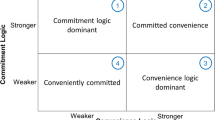Abstract
This study explores the optimal payout structure and prize distribution of instant (scratch-off) lottery games. Using ticket sales data for 185 instant lottery games sold between 2007 and 2011 by the Maryland State Lottery and Gaming Control Agency, we calculate the price elasticity of demand across a range of ticket denominations. Our findings suggest that increasing the payout rate of instant tickets will increase revenue, particularly among low denomination tickets. We also find that reallocating the current prize distributions within a game towards fewer, but more valuable, low-tier prizes will increase the number of tickets sold.

Similar content being viewed by others
Notes
For example, Price and Novak (2000) found Texas lottery games to be a regressive form of taxation, with instant games being more regressive than other games. This finding is consistent with much of the prior literature on the topic (e.g. Clotfelter and Cook, 1987; Hansen, 1995). On the other hand, Garrett and Kolesnikova (2010) found that after controlling for cost of living differences, income elasticities are greater, suggesting that this regressivity is overstated and in some cases lotteries can be progressive.
For an extensive review of the current literature on the economics of lotteries, see Grote and Matheson (2011).
After the MLGCA determines that a game has sold more than 90 % of its run, they examine the remaining prizes available and determine whether or not to close a game based on the availability of any remaining top prizes. While a game may be removed due to lack of sales or popularity, this is rare, as the marginal cost of leaving the game open is low. While some states are required by law to pull games after all jackpots are won, the MLGCA is not required to do this for their instant games.
The elasticity estimates here indicate that an increase in payout of 1 % will translate into a 1.2 % increase in the number of tickets sold, so increasing payout rates by 5 % will increase sales by 6 %.
References
Chen, S.H., & Chie, B.T. (2008). Lottery markets design, micro-structure, and macro-behavior: An ACE approach. Journal of Economic Behavior & Organization, 67 (2), 463–480.
Clotfelter, C.T., & Cook, P.J. (1987). Implicit taxation in lottery finance. National Tax Journal, 40(4), 533–46.
Combs, K.L., Crowley, J.E., & Spry, J.A. (2013). The effect of New Jersey lottery promotions on consumer demand and state profits. Eastern Economic Journal, 00, 1–23.
De Boer, L. (1990). Lotto sales stagnation: Product maturity or small jackpots? Growth and Change, 21(1), 73–77.
Forrest, D., Gulley, O.D., & Simmons, R. (2000). Elasticity of demand for UK national lottery tickets. National Tax Journal, 53(4), 853–64.
Forrest, D., Gulley, O.D., & Simmons, R. (2004). Substitution between games in the UK national lottery. Applied Economics, 36(7), 645–651.
Forrest, D., Perez, L., & Baker, R. (2010). Evaluating the effects of game design on lotto sales: A case study from Spain. Journal of Gambling Business & Economics, 4(2), 1–19.
Forrest, D., Simmons, R., & Chesters, N. (2002). Buying a dream: Alternative models of demand for lotto. Economic Inquiry, 40(3), 485–496.
Garrett, T.A., & Kolesnikova, N.A. (2010). Local cost of living and demand estimation: An application to state lotteries. Working Paper 2010-035E, Federal Reserve Bank of St Louis.
Grote, K., & Matheson, V. (2006). Dueling jackpots: Are competing lotto games complements or substitutes? Atlantic Economic Journal, 34(1), 85–100.
Grote, K., & Matheson, V. (2011). The economics of lotteries: A survey of the literature. Working Papers 1109, College of the Holy Cross, Department of Economics.
Haisley, E., Mostafa, R., & Loewenstein, G. (2008). Myopic risk-seeking: The impact of narrow decision bracketing on lottery play. Journal of Risk and Uncertainty, 37(1), 57–75.
Hansen, A. (1995). The tax incidence of the Colorado state lottery instant game. Public Finance Quarterly, 23(3), 385–98.
La Fleur, B. (2014). La Fleur’s World Lottery Almanac. Boyds: TLF Publications, Inc.
Maryland Lottery and Gaming Control Agency (2013). Fiscal year 2013 year-end review. Retrieved from http://mlgca.com/annual-report/.
Matheson, V., & Grote, K. (2005). Examining the halo effect in lotto games. Working Papers 0513, College of the Holy Cross, Department of Economics.
O’Malley, M., Brown, A.G., & Foster, T.E. (2013). Maryland budget highlights FY 2013.
Papachristou, G.A. (2006). Is lottery demand elasticity a reliable marketing tool? Evidence from a game innovation in Greece. International Review of Economics, 53 (4), 627–640.
Price, D.I., & Novak, E.S. (2000). The income redistribution effects of Texas state lottery games. Public Finance Review, 28, 82–92.
Thiel, S.E. (1991). Policy, participation and revenue in Washington state lotto. National Tax Journal, 44(2), 225–35.
Walker, I. (1998). Lotteries: determinants of ticket sales and the optimal payout rate. Economic Policy No. 27.
Author information
Authors and Affiliations
Corresponding author
Rights and permissions
About this article
Cite this article
Coon, M., Whieldon, G. Elasticity of Demand and Optimal Prize Distribution for Instant Lottery Games. Atl Econ J 44, 457–469 (2016). https://doi.org/10.1007/s11293-016-9512-8
Published:
Issue Date:
DOI: https://doi.org/10.1007/s11293-016-9512-8




